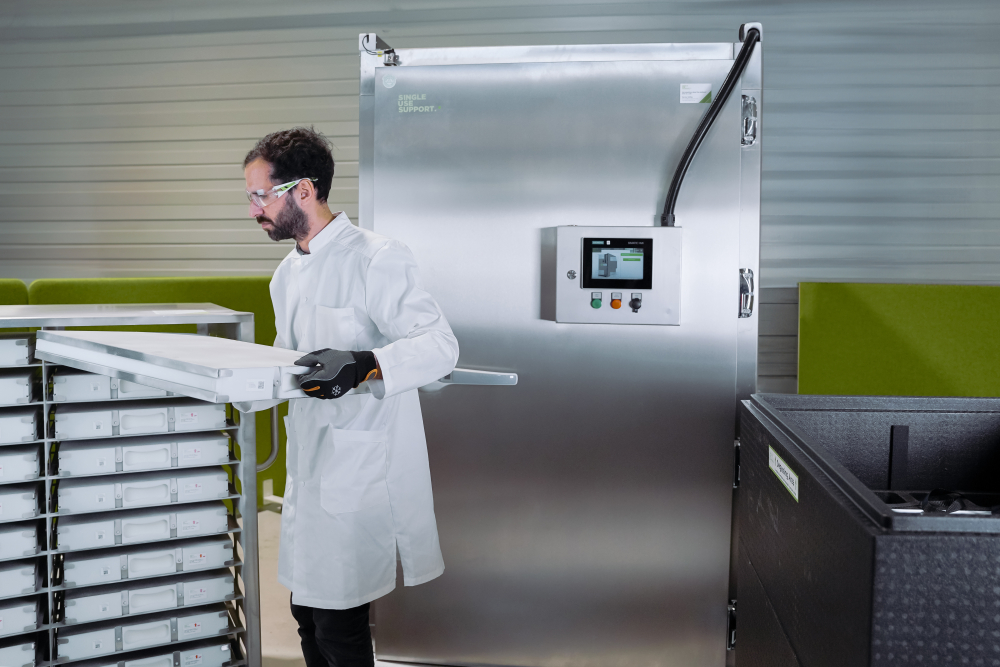Protein storage: How to increase protein stability?
Table of contents
ShowWith the rapid advancements in biotechnology and the growing importance of protein-based therapeutics, ensuring the stability of proteins during storage has become paramount. Proper storage conditions are crucial for maintaining the structural integrity and functional activity of proteins, preventing degradation, aggregation, or a reduced state of activity over extended periods of time.
In this article, we will explore the various factors that influence protein stability during storage and discuss strategies to optimize protein storage conditions.
Protein stability – what is it, and how is it assessed?
Protein stability refers to the ability of a protein molecule to maintain its native conformation and functional activity under various environmental conditions, such as temperature, pH, and the presence of denaturing agents.
To assess protein stability, researchers employ a variety of biophysical techniques and biochemical assays. These methods aim to characterize the structural integrity of biologics and monitor any changes that may occur under different conditions. Biophysical techniques, such as circular dichroism spectroscopy or fluorescence spectroscopy, provide valuable insights into protein folding, stability, and dynamics at the molecular level. Additionally, biochemical assays, including protein-protein interaction assays, are used to evaluate the functional integrity of proteins and detect any signs of proteolysis or degradation.12
Ensuring protein stability is essential not only for basic research in biochemistry but also for various applications in biotechnology, pharmaceuticals, and medicine. By elucidating the factors that influence protein stability and developing robust assays for its assessment, researchers can better design and optimize therapeutic proteins, improve protein engineering strategies, and enhance the storage and handling of protein samples.
1 2
How to stabilize proteins before freezing
Before proteins undergo freezing, it's crucial to employ effective strategies to enhance their stability and minimize the risk of degradation. Several key approaches can achieve this goal, ensuring that proteins retain their structural integrity and biological activity during the freezing process.
One essential consideration is the formulation of the protein solution. Optimizing factors such as buffer composition, pH, and the presence of stabilizing agents can create formulations that provide an optimal environment for protein stability. Also, the addition of reducing agents and protease inhibitors (e.g. EDTA) can help maintain protein stability by preventing disulfide bond formation and inhibiting cysteine oxidation.3

Protein storage conditions – factors that affect protein stability
Protein stability during storage is influenced by various factors that must be carefully managed to preserve the protein's structural integrity and functional activity. Some of the most crucial factors (that are therefore going to be discussed in more detail hereafter) include:
- Protein concentration
- Cryoprotective agents
- Storage duration
- Storage temperature
- Freeze/thaw methods
Protein concentration
Protein concentration greatly influences stability during storage. High concentrations of purified proteins reduce the risk of inactivation, conserves space and resources. Concentrated aliquots minimize freeze-thaw cycles, preserving protein integrity. This ensures prolonged shelf life and integrity, vital for downstream applications.4
In cases where high concentrations (> 1 mg/ml) are not to be reached, filler proteins like bovine serum albumin (BSA) may be added.4 5
Cryoprotective agents and other additives
Cryoprotective agents are essential additives used to mitigate damage caused by freezing and thawing processes. Cryoprotectants like glycerol, ethylene glycol, and sucrose function by reducing the formation of ice crystals and stabilizing protein structures during freeze-thaw cycles.6
Sodium azide or thimerosal, on the other hand, function as antimicrobial agents by inhibiting microbial growth during storage, further protecting protein integrity.6 7
Protein storage duration
Protein storage duration significantly impacts protein stability and degradation. Whether proteins are stored for short-term or long-term periods, reacting to the effects of storage duration is crucial for maintaining protein integrity and maximizing shelf life.
Short-term storage refers to storing proteins for a relatively brief period, typically ranging from hours to a few days or weeks. During this time, measures such as proper temperature control and protection from contaminants help maintain stability.
In contrast, long-term storage involves storing proteins for extended periods, ranging from months to years. Prolonged storage increases the risk of protein degradation due to factors such as oxidation, enzymatic activity, and changes in pH or temperature. Therefore, careful monitoring and optimization of storage conditions are necessary to preserve protein stability over time.
Depending on how long the storage of proteins is planned to last, the storage conditions must be adapted (e.g. solution preparation or storage temperature).8

Storage temperature
Storage temperature plays a crucial role in preserving protein stability and preventing degradation. Proteins can be stored at various temperatures, each offering different levels of stability and shelf life.
Prolonged storage at room temperature can accelerate protein degradation due to increased enzymatic activity and the risk of microbial contamination. Therefore, for short-term storage (e.g. up to a month), diluted proteins can be stored at a temperature of 4 °C.9
To extend shelf life and maintain protein stability for longer durations, proteins are often stored at low temperatures. Temperatures of -20 °C slows down enzymatic activity and helps preserve protein integrity for up to one year. For even longer-term storage, proteins can be stored at ultra-low or even cryogenic temperatures, such as those achieved with liquid nitrogen (-196°C), which effectively halts biochemical reactions and ensures protein stability for years.9 10
Protein freezing and thawing methods
The utilized freezing and thawing methods – from lyophilization (freeze-drying) to cryogenic freezing – significantly impact protein stability. Controlled freezing rates are essential to minimize denaturation and maintain protein integrity during freeze-thaw cycles. Traditional methods like slow freezing or snap freezing in liquid nitrogen may result in uneven cooling and denaturation.
In contrast, controlled-rate plate freezing offers precise temperature control, reducing denaturation risks and effects like cryoconcentration. Equally, thawing processes must also be carefully managed to avoid protein damage and ensure optimal protein stability throughout freeze-thaw cycles.
Improving protein storage conditions with Single Use Support
Protein storage is a critical aspect of biopharmaceutical manufacturing, ensuring the stability and integrity of valuable amino acids, peptides, enzymes, and more complex proteins, such as therapeutic antibodies. Furthermore, as storage space is precious, efficient cold storage solutions have to be implemented in order to save energy and financial resources.
Single Use Support offers scalable solutions tailored to optimize protein production, also preserving the potency and quality of proteins during storage. From ultra-cold storage freezers like the RoSS.ULTF to specialized packaging solutions, our products enhance the efficiency and safety of protein storage, mitigating risks associated with traditional methods.
Closed processes and safe packaging
Implementing closed processes and utilizing safe packaging is crucial in mitigating the risk of microbial growth and ensuring product integrity.
Single Use Support offers advanced solutions to safeguard biopharmaceuticals throughout storage and transport. The closed systems minimize contamination risks, while single-use bioprocess containers and RoSS® Shell as a protective packaging solution provide an effective barrier against external contaminants.
Controlled freezing and thawing
Single Use Support's RoSS.pFTU platform provides advanced solutions for controlled freezing and thawing processes. The RoSS.pFTU systems (abbreviated for “plate-based freeze and thaw unit”) ensure precise temperature control during both freezing and thawing stages, minimizing the risk of protein degradation and maintaining structural integrity.
Even lower temperatures can be achieved with the cryogenic freezer RoSS.LN2F. This system allows controlled freezing down to temperatures as low as -170 °C with controlled exposure to liquid nitrogen.
By incorporating sophisticated temperature management, Single Use Support’s freezing platforms offer optimal conditions for preserving the efficacy of biopharmaceutical products.
Temperature control during protein storage
Maintaining precise temperature control is essential for preserving the stability and integrity of proteins during storage.
With the RoSS.ULTF ultra-cold storage freezer from Single Use Support, biopharmaceutical companies can ensure optimal conditions for protein storage, even at ultra-low temperatures down to -75 °C. This ensures that proteins remain stable and active, mitigating the risk of degradation and maintaining product efficacy. RoSS.ULTF offers unmatched temperature control, safeguarding the quality of stored proteins throughout their lifecycle.
- Mass Spectrometry Methods for Measuring Protein Stability, http://dx.doi.org/10.1021/acs.chemrev.1c00857, Published 2022-03-22
- The Protein Man's Blog | A Discussion of Protein Research., https://info.gbiosciences.com/blog/methods-of-determining-protein-stability , Published 09/2018
- Protein stability and storage. No date. , https://wolfson.huji.ac.il/purification/PDF/StorageProteins/PIERCE_ProteinStorage.pdf , Published
- Protein stability and storage. No date., https://wolfson.huji.ac.il/purification/PDF/StorageProteins/PIERCE_ProteinStorage.pdf , Published
- What you wish you knew before storing your protein in the freezer., https://nanotempertech.com/blog/what-you-wish-you-knew-before-you-stored-your-protein-in-the-freezer/ , Published 06/2019
- Protein stability and storage. No date., https://wolfson.huji.ac.il/purification/PDF/StorageProteins/PIERCE_ProteinStorage.pdf , Published
- Protein stability and storage, https://wolfson.huji.ac.il/purification/PDF/StorageProteins/PIERCE_ProteinStorage.pdf , Published
- Protein stability and storage. No date, https://wolfson.huji.ac.il/purification/PDF/StorageProteins/PIERCE_ProteinStorage.pdf, Published
- Protein stability and storage. No date. , https://wolfson.huji.ac.il/purification/PDF/StorageProteins/PIERCE_ProteinStorage.pdf , Published
- Protein stability and storage. No date, https://wolfson.huji.ac.il/purification/PDF/StorageProteins/PIERCE_ProteinStorage.pdf , Published













